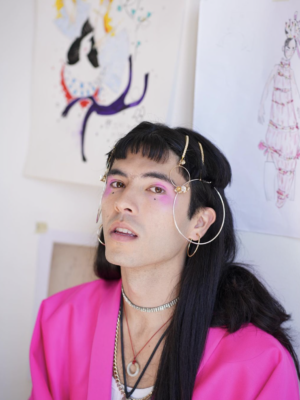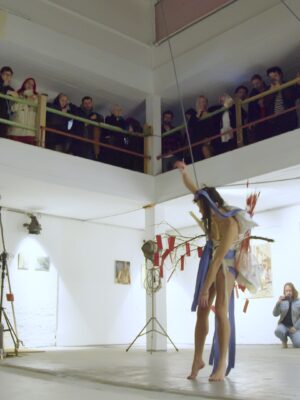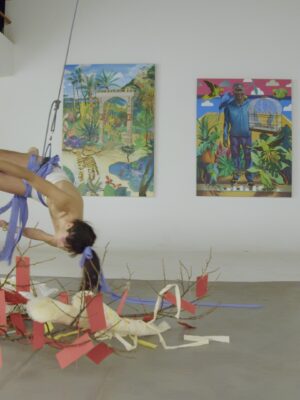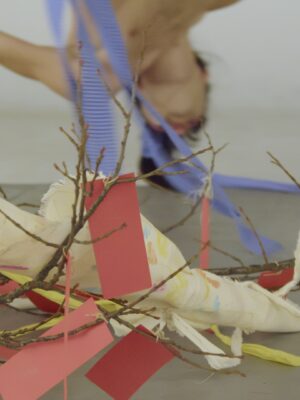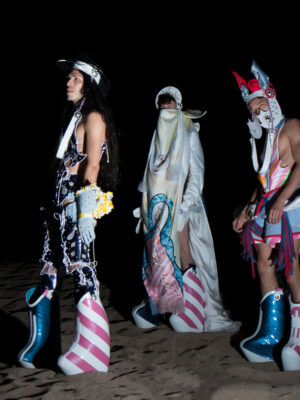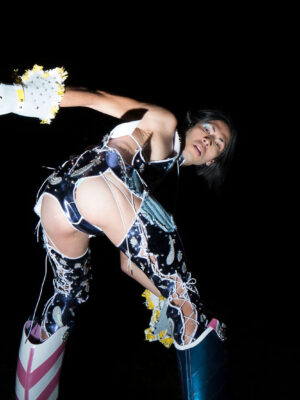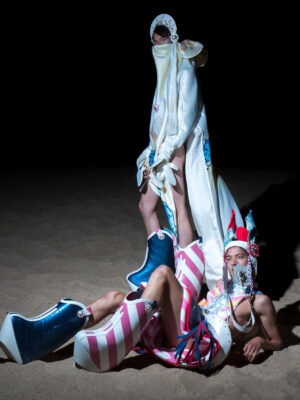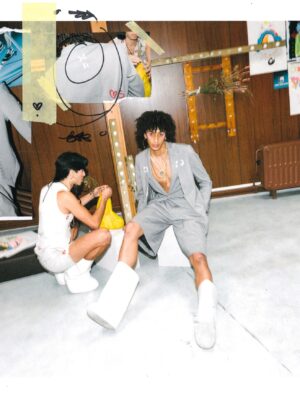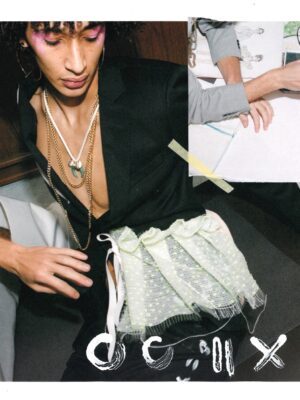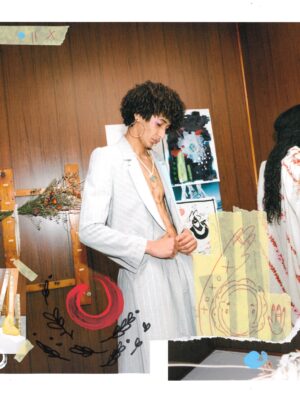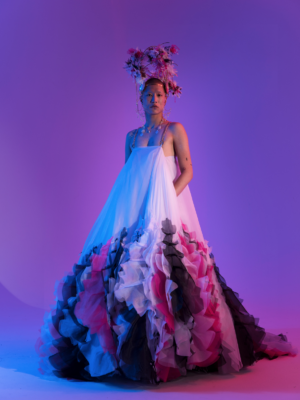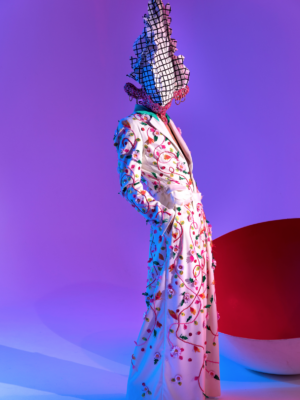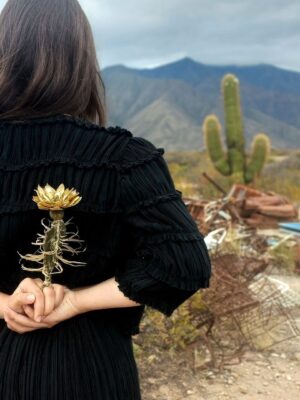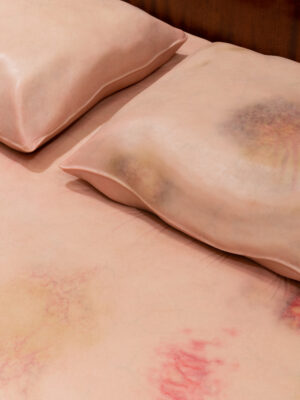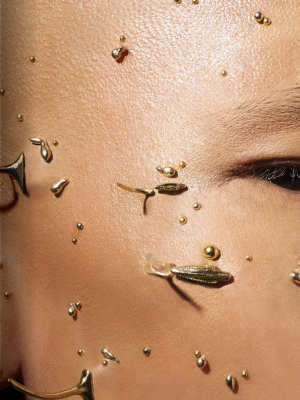Just three years after graduating, Wen returned to the Antwerp Academy in late 2022, but this time not as a student. He was appointed as the new Creative Director of the fashion department, succeeding the iconic Walter van Beirendonck.
As Wen settles into his new position, inspired by a new generation of students who celebrate authenticity, creativity, and fun, we spoke with him. The interview is composed and conducted by the participants of GEMZ, CO’s very own talent development programme.
Current Obsession: What inspires you the most right now?
Brandon Wen: What inspires me are the things that fall into my circle as I go through life. I don’t always have a theme or topic on my mind; a lot of the time, it’s the places I go. Sometimes a friend will show me something and I’ll think, ‘wow.’ I’m also inspired by my students; there is a lot that I’m learning from them.
CO: Many different sources and articles refer to you as a fashion designer and performance artist. Do you agree with these titles?
BW: I like the idea of an artist being someone whose identity is quite abstract. There are always several things that are happening; sometimes they are objects, sometimes a drawing, but it all relates, all the different pieces.
The whole process is the artwork, but in the end, you only show certain things. For me, in the end, there is clothing and there is performance, and these are two things I’ve done the most and so agree with these titles. The show aspect of fashion is what I find so interesting. The fact that we make work and then we get to celebrate it with this performative show. It’s not a static presentation, unlike many other art forms.
Brandon performing
CO: How do you typically collaborate with jewellery artists in your collections? Can you walk us through the process?
BW: It starts with me crudely making objects with what I have in my house or studio and then working with jewellers to turn them into something more refined. They recommend materials and then I would add little touches here and there. I love when you start working, it can be very crude. Sometimes we think that our work must look good from the beginning and sometimes it looks like play dough. You’re crafting something until it becomes refined.
CO: Can you explain how performance art fits into your practice? Have you had any formal training in dance or theatre?
BW: I don’t have any theatre or dance background; I did High School Musical but that’s about as professional as it gets! My interest in performance began with the show aspect of fashion and I liked being part of this show. While interning with Michèle Lamy, she had an album which she was performing. At some point, I was helping style her and she said to me, ‘Why don’t you get in the performance?’ There were some dancers, and she was going to the rehearsal, and something really clicked in that moment. It was a way to express fashion and merge what I’m feeling about the show in the presentation.
Sometimes show can become costume and there exists a fine line between costume and fashion. There is something about performance art versus theatre. Performance art is still abstract, the performance remains about clothing rather than the clothing becoming something that supports the performance. I always envied mediums like sculpture and painting; they’re very physical and you do the thing with your body. Performance allows this aspect of physicality because sometimes stitching is not the most emotional.
CO: Do you have suggestions on how to translate the performative and theatrical nature of fashion to the jewellery sector? Obviously, everything is much smaller scale.
BW: One of the important things about performance and fashion is that the clothing for a performance should be wearable. Sometimes, clothing or costume for a performance is thought of as being less wearable, but in fact, it should be more wearable.
For example, in the first performance with Michèle Lamy, we used dresses from Comme des Garçon. These dresses had extremely grandiose, strange volumes, but even if the dress had all the appendages, you still put it on the same way as a t-shirt. Ease of wear is so important when we think of clothing or jewellery so that these objects can connect, react, and move with the body. It’s important that these objects become a part of you and act like an extension of the body.
American Malaise
CO: After graduation, how did you make decisions about where and what to take as internships, work, or freelancing? Did you ever struggle with making those decisions or regret any?
BW: I tried every year when studying to get an internship and never succeeded. In my third year, I put out feelers and sent out I don’t know how many emails, and by the grace of God, I got a response. I managed it through a lot of baby steps; I asked for advice, then we talked a bit and then asked about an internship. They replied saying maybe after you graduate. A few months later, I sent my third-year collection, and in a few weeks, they contacted me saying there’s been an opening in the summer. So, it was a process. It wasn’t just me sending one thing; I sent a million things that got no responses, and then got one, but then it was still a conversation about something else.
It was strange because there were all these opportunities coming by, and often after some thought, I’d think I don’t want to do that. You feel guilty turning down opportunities, but in retrospect, I’ve realised that a lot of times, if there’s a gut feeling saying no, listen to that. Just because something is a big name or seems like a really great opportunity, if the energy is wrong, it’s maybe not the right thing. Don’t be afraid to say no and be patient. It’s okay to wait for other opportunities. If it does feel right, then you go for it, but it’s about putting a lot of leg work in, reaching out to people, and seeing what opportunities there are so that when you get one, it makes sense, and you feel comfortable pursuing it.
Don’t be afraid to say no and be patient. It’s okay to wait for other opportunities.
CO: How do you develop your own distinct identity in the fashion industry, given your diverse experiences as a designer, creative director, performance artist, and teacher?
BW: I believe that working in many different roles and aspects has helped me to develop my identity. It adds another flavour to who I am and another medium to express my art. When a project came along that seemed right but was outside of what I typically did, it only added to my repertoire. I think it’s important to explore different pathways. As an artist, my goal is to reach a point where I can say, “I feel like working on this now,” and then explore that path. I don’t want to be constricted or limited to one particular medium.
CO: You seem to have a really strong sense of self; how do you trust your gut and either develop or retain this strong sense of self? I think for many, especially when starting out, it can be quite challenging.
BW: It’s a difficult question because I’m preoccupied with it and I don’t always know the reason for the answer. I will say that I have noticed that many students have what they need. They have the talent, charisma, and work ethic. However, they lack the self-trust to believe that they are good enough to do it and create a space for themselves.
Something that has always been important to me is that I don’t necessarily see who I think I am or what I think I present in the industry. So, I keep going to make a space for myself. I deserve a spot like anyone else to be doing my thing and to be myself. That’s always a recurring thought in the back of my head. This grandiose sense of self is important to me. I think it’s necessary to believe in yourself in an over-the-top manner because otherwise, who will? You are the one rooting for yourself in the beginning, so it has to be a bit over the top.
I think it’s necessary to believe in yourself in an over-the-top manner because otherwise, who will? You are the one rooting for yourself in the beginning, so it has to be a bit over the top.
Wen’s collaboration with Café Costume, images credited to Eric Peiren.
CO: How did you gain visibility with your work? What do you think is the best way to share your work?
BW: At the end of the day, social media does a lot. I have a complex relationship with Instagram; it’s not always my friend, but it is a platform where you are the author. You can create the look and feel of what you want to present, so I think it is valuable, and we all have to just keep pushing with it. The other thing that I think is important, if you can manage it, is collaborating with people. Something that is not spoken about is that established organisations are hungry for young creativity. It’s one of the most valuable things to any creative organisation. You may have this feeling sometimes as a young person that you are treated in a disposable way, that there are a million people in line waiting outside. In reality, what they need more than anything else are people with fresh creativity and ideas, and as someone who is just starting, you naturally have a more open viewpoint.
Something that is not spoken about is that established organisations are hungry for young creativity. It’s one of the most valuable things to any creative organisation.
CO: You seem to have a fantastic network with “big names”. How would you advise someone to network?
BW: When I was in school, I used to attend Fashion Week without knowing anyone, and it was quite miserable. I would try to get into parties and do anything to meet people, but it often felt like it wasn’t working. However, in the end, it was more helpful than I had realised. The reality of networking in the fashion industry is not as glamorous as we may envision. It’s about attending openings, meeting people in your network, finding out who knows who, and making an effort to reach out. This approach has helped me to remember contacts and follow up.
Networking is a slow process. Asking for advice is significant because it is a gentle way to open a conversation and show respect. You are not asking for anything from them, and it can build a relationship over time. It also allows you to determine if you connect with the person or if they have a different viewpoint that may not be helpful. Meeting people from different art, design, and business backgrounds of all ages is important. People from different fields and age groups have different perspectives that can help you in various ways.
CO: How do you think your time working for Rick Owens and Michèle Lamy informed your own creative outlook?
BW: Michelle and Rick are the epitome of what I believe a designer and artist can be. To live in the universe that they have created, where everything about their lives is the artwork, is the total oeuvre. There isn’t a mask to take off; it’s just their everyday, and I find that really inspiring. They are so authentic, and it’s not just a show. They live their lives in a way that makes sense and is attractive to them.
CO: How has it been, a month into the job, to switch from the role from student to creative director?
BW: It has been very organic for me, I think because I remained close with the school even after I graduated. I stayed connected, for example, when I came back to Belgium, the people that I knew were my old teachers. I would go to their house for dinner, and they became my friends. So that has been beautiful, and teaching has been very organic.
I don’t subscribe to the idea of sitting up as the teacher and telling people what is and isn’t. I get into the student’s groove, sit with them, and talk about their life, world, and work. I come in with a bird’s-eye view, but at the same time, I’m in the soup with them. What hasn’t been so organic is getting used to being in a position of authority or having people listen to what I say. Sometimes we think a leader has to say yes or no and make fast decisions, but I’m working on the idea of soft leadership. Allowing time for things to grow or evolve; taking a step back, listening, and taking things into account. Being a vehicle for something to happen that’s beyond what you are or think. However, I accept that it’s not entirely democratic because, in the end, the point is for someone to decide. So, juggling decision-making and democracy has been a challenge.
I tend to be very ambitious, perhaps even a little delusional, but I see myself in these grandiose positions.
CO: Was the position of fashion department director a goal of yours? And why do you think you were chosen for the position?
BW: It was always a goal of mine. I tend to be very ambitious, perhaps even a little delusional, but I see myself in these grandiose positions. When I first came to the school, I remember thinking, “this is a great place, Walter is so cool, wouldn’t it be cool if he passed the tiara to me one day?” It was completely out of control, but I fantasize about it. This ambition has always been there. I liked the idea of being in a position of creative influence, and being a creative director of the school involves so much. You’re involved in what people see and what new generations do. So, it’s always been a goal. I did think it would come a bit later, but…!
Wen’s Master’s collection BRANDWERPEN
CO: Why do you think why they chose you?
BW: I always strive to advocate for creativity. When I graduated, I didn’t think that I had to “grow up” and abandon my creative pursuits. Instead, I continued to fight for my passion and carve out a space for myself. It was confusing at times, and I spent a lot of time explaining my work to others. People often questioned whether it was really “fashion” and suggested alternative paths for me to pursue. But for me, my work is complex and personal, and it’s important to fight for what you believe in.
I am an extremely pragmatic person. I believe that if you are creative, it’s a shame to come up with fantastical ideas and not have practical solutions to bring them to life in the real world. For me, practicality and creativity go hand in hand.
When I graduated, I didn’t think that I had to “grow up” and abandon my creative pursuits. Instead, I continued to fight for my passion and carve out a space for myself.
CO: In your Sleek magazine interview, you said you would like your students to realise ‘that they themselves have the means and chutzpah to create a space.’ I found this a wonderful statement and am curious if you could elaborate on this notion?
BW: I mentioned earlier that students have all the tools; it’s just a matter of getting the chutzpah, the charisma, and the confidence to know that you also deserve a space and to fight for that. Look for the right opportunities, find people who believe in similar things and support you, and don’t be too focused on names. If one person believes in you enough, they can take you far. Also, knowing that if you want something, you just have to wish for it hard enough and then it can come true. I know it’s super lame, but it’s about being authentic and honest with yourself about who you are, what you can do, and what you want to do. You deserve to have your own creative output, so making space for it is essential.
It’s like a vision board; if you put it on your board every day, then you’re always thinking about it, and when the right person comes along, you won’t miss the opportunities. The more time that has passed since finishing school, the more I feel shy about showing people my work and sketches. In school, everyone was crazy and wild and doing their thing, but then when you leave that zone, not everyone is doing that. Since leaving, I feel strange explaining and defending ideas, justifying their wildness. It’s a very vulnerable position, but like I said, knowing who supports you and having solid foundations of friends and supporters who make you feel full and whole is key.
CO: Thank you for your time Brandon.
BW: Thank you, I really appreciate it. Peace and love.
This interview was edited for clarity.
